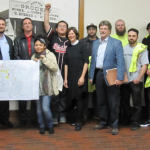VTA Surplus Land: Joint Development Policy
By Zoe Mullendore, Silicon Valley Leadership Group
There is an intrinsic nexus between housing and transportation since people choose transit options based on where they live. Creating sustainable options to get people from point A to point B requires smart planning from both housing and transit perspectives. Therefore, it’s time for transportation agencies to embrace their role in helping to provide affordable housing for transit users. Through our work with the Great Communities Collaborative, the Silicon Valley Leadership Group and Working Partnerships USA have begun to examine how to increase ridership of the Valley Transportation Authority’s (VTA) transit network while also reducing greenhouse gases by building affordable housing near transit stations. We plan to work with VTA to establish goals and targets around Transit Oriented Development (TOD) within their real estate holdings.
For a bit of background, VTA was established in 2000, taking over operations from the previous Santa Clara County transit agency. VTA has a unique structure of serving as both the Congestion Management Agency (CMA), who has purview over roads and highway projects, in addition to being the county’s transit operator. VTA currently operates an extensive bus and light rail service network and will soon own and operate the BART to Silicon Valley extension to downtown San Jose and Santa Clara.
In addition to its transportation network, VTA holds over 500 acres in land across Santa Clara County And 315 acres are ‘surplus’ land, which VTA has the ability to hold, sell or lease. A Joint Development Policy (JDP) guides how VTA’s decisions regarding selling or leasing this land. VTA’s JDP was created in 2007 and allows private developers to buy or lease land owned by VTA. The pot of funds created by this policy generates a revenue stream that is then redistributed back into its current transportation system to increase ridership and support TOD. To-date, this policy has been underutilized but VTA is looking to begin leasing additional parcels in the coming years.
However, of the Joint Development Policy’s three priorities—revenue, increased ridership and exploration of TOD—none mentions the need for affordable housing near its transit stations. The Silicon Valley Leadership Group sees the link to affordable housing as a tremendous market opportunity. A recent study conducted by TransForm and California Housing Partnership Corporation found that low income residents were four times as likely to ride transit as their wealthy counterparts and that low income citizens used transit far more frequently when the transit was located close to their homes. This study demonstrates that not only does it make economic sense to build affordable housing near transit; it also increases ridership of the overall system, highlighting the market advantage of incorporating low income residents into the public transit system. Instead of bringing the transit to the people; bring the people to the transit.
The good news is that there are some great examples of Joint Development Policies that emphasize transit agencies’ role in affordable housing. Most notably, Boston’s MTBA cites affordable TOD as its 2nd priority and requires 25% of all units in housing projects to be affordable. Portland, OR’s transit agency has leveraged over $300 million to build 2,100 units (of which 1,200 units have been affordable) across 24 different station areas. These policies use different mechanisms to achieve increased affordable housing on their land but agree that it’s economically advantageous to place affordable housing on their surplus land because ridership inevitably increases. Many other transit agencies across the country have adopted JDP’s that include affordable housing as a development priority as well.
TOD is a key priority to our transportation and housing work here at the Leadership Group and we view this as a great opportunity to expand the supply of affordable housing in the Valley, as well as increasing transit ridership across the VTA system. We acknowledge that not every site of surplus land is suitable for housing, but we look forward to the opportunity to engage with VTA on the subject. We’re excited to work with VTA staff and the Board to come up with a flexible policy we hope will increase ridership and decrease green house gases by putting those most likely to utilize transit, near transit.





